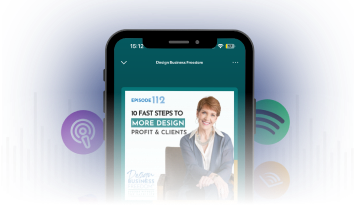7 Essentials to Setting Design Client Expectations Every Time
Setting clear and realistic expectations with your design clients is crucial for running a successful interior design business. When expectations are aligned from the start, it not only helps in delivering a smooth project but also ensures that your clients are satisfied and your business remains profitable. This post will explore the essentials of setting design client expectations every time to ensure a successful outcome.
1. Lead the Client from the Start
To create profitable design client expectations, it’s essential to take the lead from the very beginning. If you allow the client to dictate the process, it can lead to unrealistic expectations, misunderstandings, and a loss of control over the project. Instead, you should guide your client through your proven process, setting design client expectations right from the start.
2. Set Clear Boundaries
Establishing healthy business boundaries is a key part of managing client expectations. These boundaries should be communicated clearly in your initial conversations and reinforced in your letter of agreement. By setting design client expectations and limits on what you can and cannot do, you protect yourself from being overextended and ensure that the project remains profitable.
3. Address the Elephant in the Room: Budget and Timeline

One of the biggest pitfalls in any design project is a mismatch between client expectations and reality when it comes to budget and timeline. You must be upfront about these aspects from the very first conversation. Use your experience to provide realistic timelines and budgets, and don’t shy away from discussing potential delays, surcharges, or other issues that might arise. Transparency here is key to setting design client expectations that align with reality.
4. Use a Detailed Agreement
A thorough and well-crafted design agreement is essential for setting clear expectations. This document should outline every aspect of the project, from the scope of work to payment schedules and potential changes. Walk your client through this agreement to ensure that they fully understand what to expect. This reduces the likelihood of disputes or misunderstandings later. This step is crucial in setting design client expectations effectively.
5. Frame the Experience as a Journey
While it’s important to be realistic about the challenges of a design project, you should also frame the experience in a positive light. Remind your clients that the process, though sometimes difficult, will lead to a beautiful and functional space that they will enjoy for years to come. Keep the focus on the joy and long-term benefits. This helps you maintain their enthusiasm and cooperation throughout the project, making setting design client expectations an enjoyable process.
6. Regularly Communicate Updates
Clients want to feel informed and involved, so it’s important to establish a regular schedule for updates. You can schedule these weekly or biweekly. Whatever interval you choose, these updates should be concise and informative. Specifically, they can cover what has been accomplished, what’s coming next, and any potential issues. Regular communication is key to setting design client expectations and keeping clients at ease, reinforcing their trust in your process.
7. Be Ready to Enforce Your Expectations
It’s one thing to set expectations, but it’s another to enforce them. If a client starts to push boundaries or ignore agreed-upon processes, you need to be prepared to step in and reinforce the expectations you’ve set. This might involve reminding them of the terms of your agreement or having a candid conversation about the impact of their actions on the project’s success. Enforcing the expectations you’ve set is the final step in setting design client expectations effectively.
Key Takeaway
Creating and managing client expectations is a critical component of running a profitable and stress-free design business. By leading the client from the start, setting clear boundaries, addressing budgets and timelines, using a detailed agreement, framing the process positively, maintaining regular communication, and enforcing your expectations, you can ensure that your projects run smoothly and your clients remain satisfied.If you’re ready to increase your interior design practice profits, work exclusively with ideal clients, and enjoy the time and resources for your extraordinary life, explore your coaching options. We’ve got your back in the business of interior design.





